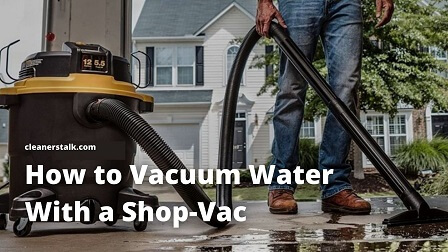
How to Vacuum Water with a Shop-Vac (Complete Guide)
Cleaners Talk is reader-supported. This post contains affiliate links, we may earn a commission at no additional costs to you. As an Amazon Associate we earn from qualifying purchases.
Your floors are soaked, and you need to suck up the water before anything gets ruined. A Shop-Vac is a handy tool to solve this problem. By following some simple guidelines, you will be able to vacuum the water up.
Although using a Shop-Vac is easy, you need to take steps to ensure your Shop-Vac does not become ruined. Proper use also ensures your safety. Let’s explore how the Shop-Vac works and how to use it properly.
How to Vacuum Water with a Shop-Vac
It is possible to use a Shop-Vac to remove water and other non-flammable liquids from hard or carpeted floors. Make sure the vacuum is empty. Remove the dry vacuum bag. Replace the dry filter with the wet filter. Attach the wet vacuum head to the vacuum hose. Turn your Shop-Vac on and begin vacuuming up the water.
1. Empty Contents of the Shop-Vac
Make sure the vacuum is unplugged. Open the Shop-Vac by unlatching the clips on the sides of the canister. If there is a bag inside the wet/dry vacuum, remove it. If there are dust and dirt in the dry bag, this can be emptied into a trash bag and discarded.
Check to make sure there is not any hardware such in the collection bag if the vacuum was used in a shop setting. If there is anything that should be saved, be sure to remove it before discarding the bag's contents. Check inside the canister to make sure there isn’t any dirt or debris inside it.
2. Check the Filter of the Shop-Vac
Now that you have cleaned out the canister, it is time to check the filter of the wet/dry vacuum. This filter is found inside the lid under the motor.
If the vacuum has been used for dry vacuuming, this is the paper filter you will likely see. If it is a paper filter it needs to be removed. Just undo the screw in the bottom of the filter and pull it off.
Change This Paper Filter
- Compatible with 90304 / 90350 / 90333 filters; Compatible With Shop Vac most 5 Gallon+ Wet/Dry Vacuum;
- Compatible With Type U 9030400, Type X 9035000, Type W 9034000 Filters, models BLB450, SSP16-500A, SSP16-600C, SS12-350A, SS14-450, SS16-SQ550, SS16-SQ650,...
- Compatible With 90340 SL16-575A SS11-450 SS12-300A SS14-350A SS14-550A SS14-600C 16RT500A 16RTP550A 4045AH 85L450 85L575 SS16-450 SS16-550A SS16-650C...
Into This Wet Filter
- Foam filter for wet dry vacuum cleaners are designed specifically for wet pick up
- Replacement foam sleeve is a foam filter for wet dry vacuum cleaners that can be removed and cleaned with water
- Designed to fit: Most Shop-Vac branded shop vacuums. Not for use with WORKSHOP Wet/Dry Vacuum products
Now you need to replace the dry filter with the wet filter. This is what a wet filter looks like. It is made of foam. Simply slip this foam filter over the filter holder in the center of the lid. The filter holder resembles a cage. Once you have replaced the filter on your Shop-Vac, put the lid back on the canister and lock it in place.
3. Use the Correct Suction Tools
Your shop vacuum comes with multiple tool heads that attach to the hose. Do not use any nozzles with brushes or motors on them. Water could damage them. Use only the heads designed specifically for suctioning up liquids. Some Shop-Vac heads to choose from for liquid pick up are
- The Utility Claw is designed to fit snuggly against the floor to prevent excess air from being sucked into it. This creates a better, deeper suction allowing you to vacuum up liquids with ease.
- Use with 1-1/4, 1-1/2 and 2-1/2-Inch hose ends
- Great for car interiors, seats and mats
- GOT DIRT? Shop-Vac's full line of products includes cordless, rechargeable wet dry vacuums, automotive vacuum systems, air movers, attachments & more....
- A Wet Nozzle looks like a normal vacuum head without the brush inside of it. It works the same way but is designed to pick up liquids.
- DESIGNED FOR WET PICK-UPS: 14 in. wide nozzle is perfect for large, wet messes
- IDEAL FOR HARD SURFACES: Rubber squeegee provides a thorough clean on hard floors
- INDUSTRIAL-GRADE CONSTRUCTION: CRAFTSMAN wet dry vacuum attachments are built to handle heavy use
- A Crevice Tool can be used for wet and dry vacuuming. This is an excellent choice if you need to remove water from crevices or baseboards of walls.
- A wet dry vacuum crevice tool lets a user gets into tight spaces
- This shop vacuum attachment cleans hard to reach cracks and crevices unlike most wet dry vacuum accessories that are too bulky for a tight space
- 1-1/4-inch diameter vacuum accessories are designed for maneuverability in tight spaces
- The Squeegee Nozzle has a rubber attachment in the head and works like a window squeegee by pulling the water towards the vacuum suction, helping to remove the liquid and dry the floor.
- COMPATIBILITY – PLEASE CHECK YOUR MACHINE FOR COMPATIBILITY BEFORE PURCHASE. Standard 1.25” (32mm) inner diameter fitting that is compatible with...
- HIGH QUALITY – Made with tough ABS material for long service while handling any type of cleaning job. Our 1.25” replacement vacuum attachments are made...
- USA BASED - Our replacement parts and accessories are proudly distributed in the USA with our customer service residing here as well. Have a question about...
- A Carpet Extraction Tool, is designed to get deep into the carpet to remove liquids and stains.
- Short of removing carpet, sub surface extraction is the best method for flushing out the true cause of odors and reappearing spots.
- The SOS Tool uses a process called sub-surface extraction.
- Sub Surface Extraction is used by professional carpet cleaners to thoroughly remove contaminants, liquids, and odors that have soaked into carpet padding...
You should also check your shop vacuum hose. You do not want the suction hose to be too long, as this makes your Shop-Vac work harder.
You also do not want a hose that is too short. A short hose could result in your Shop-Vac tipping over. If the Shop-Vac tips over, the liquid causes the vacuum to register as full, and you will lose suction.
Begin Cleaning up the Water
Before you start cleaning up the liquid please ensure it is not a combustible substance such as gasoline. You should never use an electric tool to clean up flammable substances due to fire or explosion risk. If you know the liquid is something basic like water, plug your Shop-Vac in and turn it on.
1. Vacuuming a Wet Carpet
Wet carpeting needs immediate attention. The longer a carpet is wet the more likely there will be damage to the carpet padding and the floor beneath it.
Wet carpet will also develop a foul odor if the water is not removed quickly. Water damage can cause:
- Mold
- Mildew
- Stains
If you have a carpet extraction nozzle, place this on the Shop-Vac hose or the rigid plastic wand that attaches to the hose, if you are using one. Take the hose and extend it as far as you comfortably can in front of you. Very slowly, pull the nozzle back toward yourself. You should be able to hear the Shop-Vac sucking up the water.
2. Vacuuming a Wet Bare Floor
It is important to clean up wet surfaces quickly as water will destroy flooring such as wood and linoleum by causing it to swell. Moisture will also ruin the finish of hardwood flooring. Wet areas are also prone to mildew and mold growth.
Use the nozzle you feel will work best for your situation. If you have a squeegee nozzle, this might be the best choice. Slowly drag the head of the vacuum over the wet area. You will be able to see the liquid being sucked off the floor. You can use other attachments to remove water from baseboards and cabinets easier.
3. Emptying Your Shop-Vac
You will need to empty the Shop-Vac canister as it becomes full of the water. As you are vacuuming listen to the sound that your shop vacuum is making. As it fills up, the sound it makes will change. When the sound changes, it is time to empty the canister.
Turn off your Shop-Vac and unplug it. Take the wet/dry vacuum to your designated place to empty it. Water without debris in it could be emptied down a drain in a toilet or tub. However, debris should not be emptied into a drain, as this could cause a block in your pipes and result in more water for you to clean up.
You can safely empty the water from your Shop-Vac outside so long as it has not been used to clean up toxic materials. Take your Shop-Vac to an area outside and slowly pour the water out.
Remove any bits of plastic or garbage and discard them in the trash. Check for small items you may have vacuumed by accident, such as jewelry pieces.
After you have emptied the canister, you will need to continue vacuuming the wet floor until you have removed as much as possible. Your carpet or hard floor will probably be slightly damp when you are finished. To help dry carpeting quicker you could place a fan in the room and direct the airflow over the carpet.
Clean Up and Care of Your Shop-Vac
And there you have it, how to vacuum water with a Shop-Vac.
Empty any remaining liquid in the collection bin. Remove the wet filter, rinse it with water, then allow the filter to air-dry. Add warm soapy water to the collection bin and scrub it with a cloth or sponge. Empty the bin and refill it with water to rinse it. Empty it again.
Use a clean, dry cloth to dry out the collection bin and the lid area before putting the Shop-Vac back together. Clean the hose and other tools you used in a sink of warm soapy water. Rinse these well and allow to air dry. Hang the hose so water can drain out of it and the air can circulate through it.
These steps will help ensure your Shop-Vac is operational for its next use.
You may also want to read:

Ryan O'Connor
I write about house cleaning and vacuum cleaners. For me, nothing is more important than a clean environment to ensure both a healthy and happy life. Learn more.







